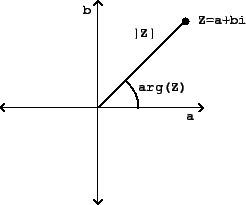




Next: Sinusoids as geometric series
Up: Time shifts
Previous: Time shifts
Contents
Index
Complex numbers
Complex
numbers are written as:
where  and
and  are real numbers and
are real numbers and  . (In this book we'll use
capital letters to denote complex numbers and lowercase for real numbers.)
Since a complex number has two real components, we use a Cartesian plane (in
place of a number line) to graph it, as shown in Figure 7.1. The
quantities
. (In this book we'll use
capital letters to denote complex numbers and lowercase for real numbers.)
Since a complex number has two real components, we use a Cartesian plane (in
place of a number line) to graph it, as shown in Figure 7.1. The
quantities  and
and  are called the
real
and
imaginary parts of
are called the
real
and
imaginary parts of  , written as:
, written as:
Figure 7.1:
A number,  , in the complex plane. The axes are for the real
part
, in the complex plane. The axes are for the real
part  and the imaginary part
and the imaginary part  .
.
 |
If  is a complex number, its
magnitude,
written as
is a complex number, its
magnitude,
written as  , is just the distance in the plane from the origin to the
point
, is just the distance in the plane from the origin to the
point  :
:
and its
argument,
written as
 ,
is the angle from the positive
,
is the angle from the positive  axis to the point
axis to the point  :
:
If we know the magnitude and argument of a complex number (say they are  and
and
 , for instance) we can reconstruct the real and imaginary parts:
, for instance) we can reconstruct the real and imaginary parts:
A complex number may be written in terms of its real and imaginary parts
 and
and  (this is called
rectangular form), or alternatively in
polar form,
in terms of
(this is called
rectangular form), or alternatively in
polar form,
in terms of  and
and  :
:
The rectangular and polar formulations are equivalent, and the equations above
show how to
compute  and
and  from
from  and
and  and vice versa.
and vice versa.
The main reason we use complex numbers in electronic music is because they
magically encode sums of angles. We frequently have to add angles together in
order to talk about the changing phase of an audio signal as time progresses
(or as it is shifted in time, as in this chapter). It turns out
that, if you multiply two complex numbers, the argument of the product is
the sum of the arguments of the two factors. To see how this happens,
we'll multiply two numbers  and
and  , written in polar form:
, written in polar form:
giving:
Here the minus sign in front of the
 term
comes from multiplying
term
comes from multiplying  by itself, which gives
by itself, which gives  . We can spot the
cosine and sine summation formulas in the above expression, and so it simplifies
to:
. We can spot the
cosine and sine summation formulas in the above expression, and so it simplifies
to:
And so, by inspection, it follows that the product  has magnitude
has magnitude
 and argument
and argument
 .
.
We can use this property of complex numbers to add and subtract angles (by
multiplying and dividing complex numbers with the appropriate arguments) and
then to take the cosine and sine of the result by extracting the real and
imaginary parts of the result.
Subsections





Next: Sinusoids as geometric series
Up: Time shifts
Previous: Time shifts
Contents
Index
Miller Puckette
2005-02-21

![]() is a complex number, its
magnitude,
written as
is a complex number, its
magnitude,
written as ![]() , is just the distance in the plane from the origin to the
point
, is just the distance in the plane from the origin to the
point ![]() :
:
![]() and
and ![]() , written in polar form:
, written in polar form: